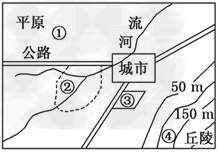问题
选择题
读“我国东部某地区局部示意图”,回答1—2题。

1.若图示地区位于东北平原中部,下列说法正确的是 [ ]
A.①地以种植冬小麦为主
B.②地利于发展蔬菜种植
C.③地最适宜种植苹果树
D.④地应大力发展乳畜业
2.若图示地区位于南部沿海地区,下列说法错误的是 [ ]
A.①地以种植水稻为主
B.②③两地发展城郊农业条件优越
C.④地可以因地制宜发展立体农业
D.耕作制度为两年三熟或一年两熟
答案
1、B
2、D
